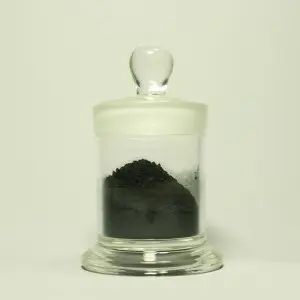Hafnium Carbide Powder (Cutting Tools and Refractory Materials)
Hafnium Carbide (HfC) Powder is a high-performance refractory ceramic material composed of hafnium and carbon. It is available in various forms, including nanopowder, submicron particles, and micron powder, providing flexibility for a wide range of industrial applications. HfC nanopowder is typically produced through Spark Plasma Sintering (SPS), while super-fine submicron HfC powders are manufactured using Vapor-Phase Synthesis for higher purity and finer particle control. HfC powder is widely used in high-temperature aerospace coatings, nuclear reactor components, and cutting tools where its superior wear resistance, thermal stability, and oxidation resistance are critical. It is also an essential material for 3D printing applications, advanced ceramics, and composite manufacturing.
Princeton Powder is a manufacturer of Hafnium Carbide ceramic powder. HfC powder can be customized and for sale at a competitive price.
Formula | Hafnium Carbide powder HfC Hafnium Carbide Nanopowder Sintered Hafnium Carbide Powder |
Morphology | Spherical or irregular |
Appearance | Black powder |
Particle Size | -325 mesh, 1-10 um, can be customized |
Melting Point | 3,890 °C |
Density | 12.2 g/cm³ |
CAS Number | 12069-85-1 |
Purity | 98% |
Description of Hafnium Carbide HfC Ceramic Powder
Hafnium Carbide (HfC) Powder is a high-performance ceramic material known for its exceptional hardness and thermal stability, with a melting point exceeding 3,900°C. It’s widely used in the aerospace and defense industries for components exposed to extreme temperatures, such as rocket nozzles, heat shields, and cutting tools. HfC is also valued in nuclear technology and the production of ultra-high temperature ceramics.
Princeton Powder is a leading supplier of Hafnium Carbide (HfC) Powder. Bulk Hafnium Carbide powder is for sale at a competitive price.
Manufacturing method of Hafnium Carbide Powder (Vapor-Phase and Spark Plasma Sintering)
Hafnium Carbide powder is typically produced through Vapor-Phase Synthesis or Spark Plasma Sintering (SPS), ensuring high purity and controlled particle sizes. These methods are used to create both nano-sized and submicron powders, catering to different industrial needs.
Main properties of Hafnium Carbide Powder
- Purity: ≥ 98% or higher
- Particle Size: From nanoparticles (<100 nm) to micron sizes (1–10 µm)
- Surface Area: Specific BET surface area for different applications
- Morphology: Spherical, irregular, or dendritic shapes depending on the use
- Application Details: Aerospace, nuclear, 3D printing, cutting tools, etc.
Chemical Composition/Particle Size of Hafnium Carbide Powder
Product | Chemical Composition (%) | |
HfC | Hf | ≥ 92 |
Total Carbon | ≥ 6.1 | |
Free Carbon | ≤ 0.5 | |
Fe | ≤ 0.05 | |
O | ≤ 0.5 | |
N | ≤ 0.05 | |
Others | ≤ 0.05 | |
Particle Size | -300 mesh, -325 mesh, -500 mesh, or customized | |
Application of Hafnium Carbide Powder
- Aerospace: HfC powder plasma spraying or CVD to create protective layers on parts like rocket nozzles or turbine blades.
- Nuclear: fuel cladding and neutron-absorbing materials
- Cutting Tools: manufacturing of cutting tools, HfC powder is mixed with tungsten carbide to form harder, wear-resistant components
- 3D Printing: HfC powder is used in selective laser sintering (SLS) or electron beam melting (EBM) to create 3D printed parts
Hafnium Carbide Powder Scholar Articles
Synthesis of Ultra-Fine Hafnium Carbide Powder and its Pressureless Sintering
- Ultra-fine HfC powders with particle sizes of 380 or 225 nm were synthesized by carbothermal reduction of HfO2 with graphite or carbon black, respectively. The investigation of the process indicated that a vacuum level as high as 5 Pa was appropriate for decreasing the reaction temperature and consequently limiting the particle growth of HfO2 reactant. Type and size distribution of carbon sources demonstrated an obvious effect on the particle size of the HfC powders obtained.
FAQ Hafnium Carbide Powder
How should Hafnium Carbide Powder be stored?
Hafnium Carbide Powder should be stored in a dry, inert atmosphere, typically under vacuum-sealed packaging or argon-filled containers to prevent moisture absorption and contamination. It should be kept in a controlled environment, away from direct heat sources.
Is Hafnium Carbide Powder hazardous?
While HfC powder is generally stable and non-toxic, it can be harmful if inhaled as fine dust. Appropriate personal protective equipment (PPE) such as respirators, gloves, and protective clothing should be used when handling the powder to minimize health risks.
Can Hafnium Carbide Powder be used in 3D printing?
Yes, HfC powder is used in additive manufacturing, particularly in selective laser sintering (SLS) or electron beam melting (EBM). It is combined with other materials to create high-performance parts that require superior heat resistance and strength for aerospace, military, and other specialized applications.

